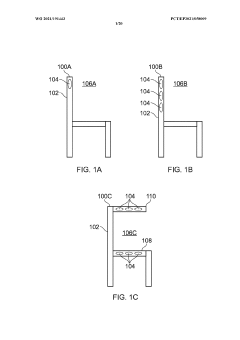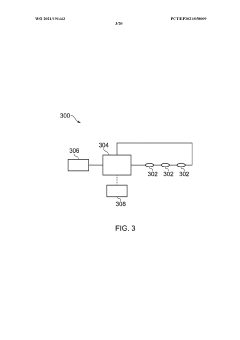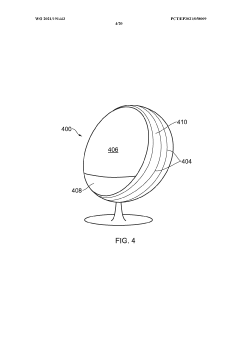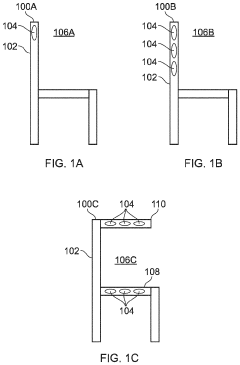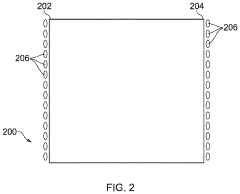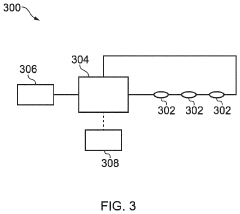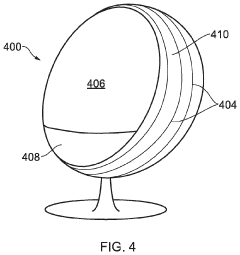Unveiling Schumann Resonance Effects on Climate Patterns
Schumann Resonance and Climate Nexus
The Schumann Resonance, a set of spectrum peaks in the Earth's electromagnetic field spectrum, has long been a subject of scientific intrigue. Recent studies have begun to unveil potential connections between these resonances and global climate patterns, opening up new avenues for understanding the complex interplay between the Earth's electromagnetic environment and its climate system.
At its core, the Schumann Resonance is generated by global lightning activity, creating standing waves in the Earth-ionosphere cavity. These resonances, typically oscillating at a fundamental frequency of about 7.83 Hz, along with higher harmonic components, form a natural electromagnetic background that has existed throughout Earth's history. The potential influence of these resonances on climate patterns stems from their interaction with various atmospheric and ionospheric processes.
One of the key areas of investigation is the relationship between Schumann Resonance variations and global temperature changes. Some researchers have observed correlations between long-term changes in Schumann Resonance parameters and global temperature trends. This has led to hypotheses about potential feedback mechanisms, where changes in global temperature might affect lightning activity, subsequently altering Schumann Resonance characteristics, which in turn could influence atmospheric processes.
Furthermore, the Schumann Resonance has been linked to variations in the ionosphere, which plays a crucial role in Earth's climate system. Changes in ionospheric conditions can affect the propagation of radio waves, impact atmospheric circulation patterns, and potentially influence cloud formation processes. These interconnections suggest a complex web of interactions between the Earth's electromagnetic environment and its climate dynamics.
Another intriguing aspect is the potential role of Schumann Resonances in biological systems and their subsequent indirect effects on climate. Some studies have explored how these resonances might influence plant growth, animal behavior, and even human physiology. While these connections are still largely speculative, they open up fascinating questions about the broader ecological impacts of Earth's electromagnetic environment.
The study of Schumann Resonance effects on climate patterns is still in its early stages, with many uncertainties and challenges. However, it represents a promising frontier in climate science, offering a unique perspective on the Earth system's interconnectedness. As research in this field progresses, it may provide valuable insights into climate modeling, long-term climate predictions, and our understanding of the delicate balance that governs our planet's environmental systems.
Global Climate Pattern Market Analysis
The global climate pattern market is experiencing significant growth as concerns about climate change and its impacts continue to escalate worldwide. This market encompasses a wide range of products and services, including climate modeling software, weather forecasting systems, satellite-based monitoring technologies, and climate risk assessment tools. The increasing frequency and severity of extreme weather events, coupled with the growing awareness of long-term climate shifts, have driven demand for more sophisticated and accurate climate pattern analysis.
Key market drivers include government initiatives to mitigate climate change impacts, corporate sustainability efforts, and the need for improved risk management in sectors such as agriculture, energy, and insurance. The market is also benefiting from advancements in data analytics, artificial intelligence, and machine learning, which are enhancing the precision and reliability of climate predictions.
The market size for global climate pattern analysis is substantial and growing. Major players in this space include established weather forecasting companies, environmental consultancies, and technology giants investing in climate-related solutions. Additionally, numerous startups are entering the market with innovative approaches to climate data analysis and visualization.
Geographically, North America and Europe currently dominate the market due to their advanced technological infrastructure and stringent environmental regulations. However, the Asia-Pacific region is expected to witness the fastest growth in the coming years, driven by increasing climate vulnerabilities and rapid economic development.
Sector-wise, agriculture remains one of the largest consumers of climate pattern analysis, as farmers seek to optimize crop yields and mitigate weather-related risks. The energy sector is another significant market, with utilities and renewable energy companies relying on climate data for resource planning and infrastructure development. The financial services industry is also increasingly incorporating climate risk assessments into their decision-making processes.
The integration of Schumann Resonance data into climate pattern analysis represents an emerging niche within this market. While still in its early stages, this approach has the potential to provide new insights into global climate systems and enhance the accuracy of long-term climate predictions. As research in this area progresses, it may open up new market opportunities for specialized climate modeling tools and services.
Current Understanding and Challenges
The current understanding of Schumann Resonance (SR) effects on climate patterns is still in its early stages, with ongoing research attempting to establish clear connections between these electromagnetic phenomena and global climate systems. SR, discovered by Winfried Otto Schumann in 1952, refers to the resonant frequency of Earth's electromagnetic cavity formed between the planet's surface and the ionosphere.
Recent studies have shown potential correlations between SR and various climate-related parameters, such as temperature, precipitation, and atmospheric circulation patterns. However, the exact mechanisms and causal relationships remain subjects of debate within the scientific community. One of the primary challenges in this field is the complexity of isolating SR effects from other atmospheric and geophysical processes that influence climate.
Researchers have observed variations in SR frequencies and amplitudes that appear to coincide with certain climate events, such as El Niño-Southern Oscillation (ENSO) cycles and extreme weather phenomena. These observations have led to hypotheses suggesting that SR may play a role in modulating global climate patterns or serve as an indicator of climate change. However, establishing direct causality remains elusive due to the multifaceted nature of climate systems and the relatively low signal strength of SR compared to other atmospheric processes.
Another significant challenge in this field is the limited availability of long-term, high-quality SR data. Continuous monitoring of SR requires specialized equipment and stable measurement conditions, which are not widely available on a global scale. This data scarcity hampers efforts to conduct comprehensive analyses and draw robust conclusions about the long-term relationships between SR and climate patterns.
The interdisciplinary nature of this research also presents challenges, as it requires expertise in atmospheric physics, electromagnetic theory, climate science, and data analysis. Integrating these diverse fields to develop cohesive models and theories that explain SR-climate interactions is an ongoing process that demands collaboration across scientific disciplines.
Furthermore, the potential influence of human activities on SR, such as the increasing use of electromagnetic technologies, adds another layer of complexity to understanding the natural variations in SR and their potential climate impacts. Distinguishing between anthropogenic and natural sources of SR variations is crucial for accurately assessing their role in climate patterns.
As research in this field progresses, scientists are working to develop more sophisticated measurement techniques, improve data collection networks, and refine analytical methods to better understand the intricate relationships between SR and climate patterns. Overcoming these challenges will be essential for unveiling the true nature and extent of SR effects on global climate systems and potentially incorporating this knowledge into climate models and forecasting tools.
Existing Climate Modeling Approaches
01 Schumann resonance monitoring devices
Various devices and systems have been developed to monitor and measure Schumann resonances. These devices can detect electromagnetic waves in the extremely low frequency range, typically between 7.83 Hz and 45 Hz. The data collected from these monitoring devices can be used to study the relationship between Schumann resonances and climate patterns, potentially providing insights into global atmospheric phenomena.- Schumann resonance monitoring devices: Various devices and systems have been developed to monitor and measure Schumann resonances. These devices can detect electromagnetic waves in the extremely low frequency (ELF) range associated with Schumann resonances. They may include sensors, antennas, and signal processing components to capture and analyze the resonance patterns, potentially providing insights into global climate patterns and atmospheric conditions.
- Climate pattern analysis using Schumann resonance data: Researchers have developed methods to analyze climate patterns using Schumann resonance data. By studying variations in Schumann resonance frequencies and intensities, scientists can potentially identify correlations with global climate phenomena. This approach may provide a new tool for understanding and predicting large-scale weather patterns and climate changes.
- Integration of Schumann resonance data with other climate indicators: Some studies have focused on integrating Schumann resonance data with other climate indicators to improve climate modeling and forecasting. By combining Schumann resonance measurements with traditional meteorological data and satellite observations, researchers aim to enhance the accuracy and reliability of climate predictions and gain a more comprehensive understanding of global atmospheric dynamics.
- Schumann resonance-based early warning systems: Researchers have proposed using Schumann resonance patterns as part of early warning systems for extreme weather events or significant climate shifts. By monitoring changes in Schumann resonance characteristics, it may be possible to detect precursors to major atmospheric disturbances or long-term climate trends, potentially allowing for improved preparedness and response to climate-related challenges.
- Artificial intelligence applications in Schumann resonance climate research: The application of artificial intelligence and machine learning techniques to analyze Schumann resonance data in the context of climate patterns is an emerging field. These advanced computational methods can help identify complex relationships between Schumann resonances and climate variables, potentially uncovering new insights into global climate dynamics and improving predictive models.
02 Climate pattern analysis using Schumann resonance data
Researchers have developed methods to analyze climate patterns using Schumann resonance data. By correlating changes in Schumann resonance frequencies and intensities with various atmospheric and climatic parameters, scientists can potentially predict weather patterns, study global temperature trends, and investigate the impact of solar activity on Earth's climate system.Expand Specific Solutions03 Integration of Schumann resonance data with other climate monitoring systems
Efforts have been made to integrate Schumann resonance monitoring with existing climate monitoring systems. This integration allows for a more comprehensive understanding of the Earth's electromagnetic environment and its relationship to climate patterns. By combining Schumann resonance data with other atmospheric and oceanic measurements, researchers can develop more accurate climate models and forecasting tools.Expand Specific Solutions04 Schumann resonance-based early warning systems for extreme weather events
Some researchers have proposed using Schumann resonance measurements as part of early warning systems for extreme weather events. Changes in Schumann resonance parameters may potentially indicate the formation or approach of severe storms, hurricanes, or other weather phenomena. These early warning systems could help improve disaster preparedness and response strategies.Expand Specific Solutions05 Artificial intelligence and machine learning applications in Schumann resonance climate research
Advanced computational techniques, including artificial intelligence and machine learning algorithms, are being applied to analyze the complex relationships between Schumann resonances and climate patterns. These technologies can process large volumes of data from Schumann resonance monitoring networks and other climate observation systems, potentially uncovering new insights into global climate dynamics and improving long-term climate predictions.Expand Specific Solutions
Key Players in Atmospheric Science
The research into Schumann Resonance effects on climate patterns is in its early stages, with a growing market interest due to potential implications for climate change understanding. The technology's maturity is still developing, as evidenced by the diverse range of institutions involved. Universities like Beijing Normal University, Peking University, and Zhejiang University are leading academic research, while research institutes such as the Chinese Research Academy of Environmental Sciences and the Institute of Geographic Sciences and Natural Resources Research contribute specialized expertise. International collaboration is evident with the University of Bern's involvement. The presence of corporate entities like SoftBank Corp. and Honeywell International Technologies Ltd. suggests emerging commercial applications, although the field remains primarily academic-driven at this stage.
Beijing Normal University
China University of Geosciences
Breakthrough Studies on Schumann-Climate Link
- A magnetic field exposure system generating an amplitude-modulated low frequency magnetic field with a carrier frequency of 360 to 450 Hz and a modulation frequency of 0.5 to 100 Hz, with a field strength of 0.5 to 250 mT, specifically designed to expose organic cells or tissues to improve cell survival, proliferation, reduce stress, and enhance well-being.
- A magnetic field exposure system generating an amplitude-modulated low frequency magnetic field with a carrier frequency of 360 to 450 Hz and a modulation frequency of 0.5 to 100 Hz, providing a field strength of 0.5 to 250 μT, specifically designed to enhance cell survival, proliferation, reduce stress, and promote tissue regeneration.
Geomagnetic Field Fluctuations Impact
Geomagnetic field fluctuations play a crucial role in the complex interplay between the Earth's magnetic field and climate patterns. These fluctuations, often associated with solar activity and cosmic ray flux, can have far-reaching effects on atmospheric processes and, consequently, on climate dynamics.
One of the primary mechanisms through which geomagnetic field fluctuations impact climate is by modulating the intensity of cosmic rays reaching the Earth's atmosphere. During periods of increased solar activity, the geomagnetic field strengthens, deflecting more cosmic rays away from Earth. Conversely, when solar activity decreases, the geomagnetic field weakens, allowing more cosmic rays to penetrate the atmosphere.
This variation in cosmic ray flux has been linked to changes in cloud formation processes. Cosmic rays can ionize air molecules, leading to the creation of cloud condensation nuclei. As a result, periods of increased cosmic ray flux may correspond to enhanced cloud cover, potentially altering the Earth's albedo and influencing global temperature patterns.
Furthermore, geomagnetic field fluctuations can affect the distribution of charged particles in the upper atmosphere, particularly in the ionosphere. This redistribution can lead to changes in atmospheric circulation patterns, potentially influencing weather systems and long-term climate trends.
Research has also suggested that geomagnetic field fluctuations may impact the behavior of the jet stream, a high-altitude air current that plays a significant role in weather patterns across mid-latitude regions. Changes in the jet stream's path or intensity, possibly influenced by geomagnetic activity, could lead to shifts in precipitation patterns and temperature distributions over large geographical areas.
Additionally, geomagnetic field fluctuations have been associated with variations in the ozone layer. The ozone layer plays a crucial role in regulating the amount of ultraviolet radiation reaching the Earth's surface, and changes in its composition or distribution can have significant implications for climate patterns and ecosystem health.
It is important to note that while the connection between geomagnetic field fluctuations and climate patterns is increasingly recognized, the exact mechanisms and extent of their influence remain subjects of ongoing research. The complexity of the Earth's climate system, with its numerous feedback loops and interconnected processes, makes it challenging to isolate and quantify the specific impacts of geomagnetic field fluctuations on long-term climate trends.
Interdisciplinary Collaboration Opportunities
The exploration of Schumann Resonance effects on climate patterns presents a unique opportunity for interdisciplinary collaboration across various scientific fields. This research area naturally bridges atmospheric physics, climate science, electromagnetic theory, and geophysics, creating a fertile ground for cross-disciplinary synergies.
Atmospheric scientists and climatologists can contribute their expertise in understanding complex climate systems and atmospheric dynamics. Their knowledge of global circulation patterns, energy transfer mechanisms, and climate modeling techniques is crucial for identifying potential links between Schumann Resonances and climate variability. Collaboration with these experts can help in developing more comprehensive climate models that incorporate electromagnetic influences.
Electromagnetic specialists and physicists play a vital role in unraveling the intricacies of Schumann Resonances. Their insights into electromagnetic wave propagation, resonance phenomena, and the Earth's electromagnetic environment are essential for establishing the theoretical framework connecting these resonances to climate patterns. This collaboration can lead to innovative approaches in measuring and analyzing Schumann Resonance data in the context of climate research.
Geophysicists bring valuable knowledge about the Earth's structure, magnetic field, and ionospheric processes. Their understanding of the Earth's natural electromagnetic environment and its interactions with solar activity is crucial for interpreting Schumann Resonance data and its potential climate implications. This collaboration can help in identifying global-scale electromagnetic phenomena that might influence climate systems.
Data scientists and computational experts are indispensable for processing and analyzing the vast amounts of data generated from Schumann Resonance measurements and climate observations. Their skills in big data analytics, machine learning, and statistical modeling can uncover hidden patterns and correlations that might not be apparent through traditional analysis methods.
Meteorologists can contribute their expertise in short-term weather patterns and local atmospheric conditions. Their insights can help in understanding how Schumann Resonances might influence local weather phenomena, potentially bridging the gap between electromagnetic effects and observable weather patterns.
Biologists and ecologists could also play a role in this interdisciplinary effort by investigating potential impacts of Schumann Resonances on ecosystems and biological processes. This could lead to a more holistic understanding of the Earth system and its response to electromagnetic phenomena.
The collaboration between these diverse fields can foster innovative research methodologies, shared resources, and novel theoretical frameworks. It may lead to the development of new tools and technologies for monitoring and predicting climate patterns based on electromagnetic indicators. This interdisciplinary approach not only enhances the potential for groundbreaking discoveries but also promotes a more comprehensive understanding of the Earth's complex climate system.
